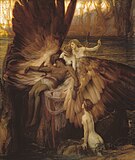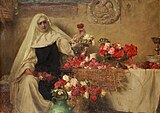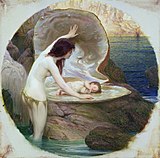Herbert James Draper
 From Wikipedia - Reading time: 7 min
From Wikipedia - Reading time: 7 min
Herbert James Draper | |
|---|---|
 Herbert James Draper | |
| Born | Herbert James Draper 26 November 1863 London, England |
| Died | 22 September 1920 (aged 56) London, England |
| Nationality | English |
| Education | St John's Wood Art School |
| Known for | Painting |
| Notable work | The Lament for Icarus, 1898 Ulysses and the Sirens, 1909 |
| Movement | Classicism |
| Awards | Gold Medal, 1890 Travelling Scholarship, 1890 |
Herbert James Draper (26 November 1863 – 22 September 1920) was an English Neoclassicist painter whose career began in the Victorian era and extended through the first two decades of the 20th century.
Life
[edit]Born in Covent Garden, London, the seventh child and only son of a fruit merchant named John James Draper and his wife Emma,[1][2] Draper was educated at Bruce Castle School in Tottenham[3] and then went on to study art at the Royal Academy.[3] He undertook several educational trips to Rome and Paris between 1888 and 1892, having won the Royal Academy Gold Medal and Travelling Studentship in 1889. In the 1890s, he worked as an illustrator, eventually settling in London. In 1891, he married Ida (née Williams), with whom he had a daughter, Yvonne.[3] He died of arteriosclerosis at the age of 56, in his home on Abbey Road.
Career
[edit]Draper's most productive period began in 1894. He focused mainly on mythological themes from ancient Greece. His painting The Lament for Icarus (1898) won the gold medal at the Exposition Universelle in Paris in 1900 and was later bought for the Tate Gallery by the Chantrey Trustees. He was also responsible for the decoration of the ceiling of the Drapers' Hall in the City of London.[3][4] His draftsmanship was excellent in sensuous portrayals of both male and female nudes;[5] several of his paintings portray proud, in some cases predatory female sexuality, for example The Gates of Dawn (1899), The Water Nixie (1908), Ulysses and the Sirens (1909)[6] and The Kelpie (1913).[5][7]
In later years as the public tastes changed and mythological scenes became less popular, he concentrated more on portraits.[3] Among his portrait subjects are the army officer Sir William Edmund Franklyn,[8] Lucius O'Brien, 15th Baron Inchiquin, his wife and his eldest son Donough as a young boy,[9] the physician Philip Pye-Smith (commissioned by Guy's Hospital),[10] the actress June Tripp (twice),[11] in addition to his wife, who may also have served as the model for his Autumn.[5][12] Draper was well-known as a portrait painter. At a charity auction for the Red Cross in 1918, his offer to paint a child's portrait brought in a bid of £250, equivalent to £15,383 in 2023.[13]
Draper took part in the annual expositions of the Royal Academy from 1890 on.[3] He was proposed for membership in 1898, 1903, 1905 and 1920, but was passed over for election.[14][5] In his last years, his popularity faded, though there has recently been a revival of interest in his work on the art market.[15][16] The Royal Cornwall Museum's 2010 auction of his The Sea Maiden and Ernest Normand's Bondage to help secure its finances generated debate about the policy of disposing of art works for this purpose.[17][18]
Gallery
[edit]-
The Sea Maiden, 1894
-
Bather, 1896
-
The Vintage Morn, 1896
-
The Foam Sprite, 1896
-
Calypso's Isle, 1897
-
The Lament for Icarus, 1898
-
For Saint Dorothea's Day, 1899
-
A Water Baby, c. 1900
-
Gates of Dawn, 1900
-
Tristan and Isolde, 1901
-
Prospero Summoning Nymphs and Deities, c. 1902
-
The Kelpie, 1903
-
Sea Melodies, 1904
-
The Golden Fleece, 1904
-
Ariadne, c. 1905
-
Art and the Jade, 1906
-
The Pearls of Aphrodite, 1907
-
The Water Nymph, 1908
-
Ulysses and the Sirens, 1909
-
The Lamia, 1909
-
By Summer Seas, 1912
-
Clyties of the Mist, 1912
-
Halcyone, 1915
-
A Young Girl by a Pool
-
In the Studio
-
The Golden Rays
-
Go Lovely Rose! Tell her that Wastes her Time and Mine
-
A Nymph in a Sunlit Glade
-
Portrait Of Miss Barbara De Selincourt
-
Ida Draper
Notes
[edit]- ^ 1871 British census St. Paul, Covent Garden
- ^ Simon Toll, Herbert Draper, 1863–1920: A Life Study, Woodbridge: Antique Collectors' Club, 2001, ISBN 9781851493784, p. 49. Toll, p. 171, notes that 1864 and 1865, both sometimes given as Draper's birth year, are incorrect.
- ^ a b c d e f The Times, September 23, 1920; p. 1; Issue 42523; col A.
- ^ Prospero summoning Nymphs and Deities, Wikimedia Commons.
- ^ a b c d George P. Landow, "A Review of Simon Toll's Herbert Draper, 1863-1920: A Life Study", The Victorian Web, 5 April 2007, retrieved 31 October 2023.
- ^ "'Ulysses and the Sirens' by Herbert James Draper", Joy of Museums Virtual Tours, retrieved 31 October 2023.
- ^ Toll, pp. 101, 134, 140.
- ^ "Works by Herbert James Draper, Art UK, retrieved 31 October 2023.
- ^ Toll, pp. 103, 105.
- ^ Toll, p. 105.
- ^ Toll, pp. 160–62, 167.
- ^ Toll, p. 88.
- ^ The Times, July 15, 1918, p. 4; Issue 41842; col A.
- ^ Toll, p. 167.
- ^ His painting The Sea Maiden was sold for £937,250 ($1,384,318) in Sale 7856 at Christie's in London, 16 June 2010.
- ^ Auction 11280, Lot 75: Herbert James Draper, By Summer Seas, Bonhams, 2004.
- ^ Tiffany Jenkins, "Don't put a price on our national treasures", The Independent, 26 July 2010.
- ^ Martin Gammon, Deaccessioning and Its Discontents: A Critical History, Cambridge, Massachusetts: MIT Press, 2018, ISBN 9780262345200, p. 114.
External links
[edit]- H J Draper (Victorian Web)
- H J Draper online (ArtCyclopedia)
- Works by H J Draper (Tate Gallery)
- H J Draper (Art Renewal Center)
- Works by Herbert James Draper at Project Gutenberg
- Works by or about Herbert James Draper at the Internet Archive
 KSF
KSF



























